Hello, fellow lovers of all things green.
About a month ago, at late dusk, I took Jolee over the footbridge across the pond to her potty spot. On the way back, I noticed an oddly flattened snake, but there was no blood, and the head was intact. How strange, given there’s no vehicular traffic other than the mower from time to time to cut down the stilt grass (Microstegium vimineum) to keep it from going to seed. The seeds of the mini-bamboo-looking trespasser stay viable for five or more years, so it’s best to cut to the chase where you can.
Mystified and intrigued by the oddity…
The snake was about two feet long in an S-shape. As I reached for my phone for a photo, it puffed up and slithered off into the ferns. So mystified and intrigued by the oddity, I didn’t make the connection that it was a copperhead, having come across several of them while hiking.
They prefer rocky wooded hillsides with wetlands and ponds, especially during the heat of summer. One time at Blue Mountain Lake’s Hemlock Pond, there were babies sunbathing on a branch above the waterline. We had Ellie at the time, not a swimmer.
Another time, a baby copperhead lunged to attack Miss Ellie while walking down Camp Road at Camp Mohican. Years before that, one swam ashore alongside Sara, my golden before Ellie. I waved her over to swim further to the right of the fishing spot, not knowing what kind of snake it was. Canine and snake landed about eight feet apart, Sara oblivious – she ran back to the water, waiting for another round of stick toss.
Surprisingly, copperheads are good swimmers.
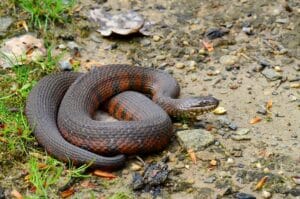
Water Snake Photo by Blaine Rothauser
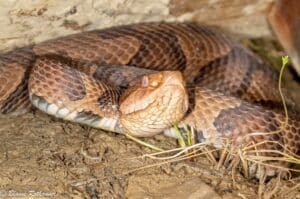
Copperhead photo by Blaine Rothauser
Eastern Copperheads (Agkistrodon contortrix) are sometimes confused with the more common and non-venomous Northern Water Snake (Nerodia s. sipedon) and Eastern Milk Snake (Lampropeltis t. Triangulum). But there’s no mistaking the coppery-brownish body with hourglass-shaped bands on copperheads. Baby copperheads are typically tan or gray rather than coppery.
A scientist from Rutgers University happened to be visiting Camp Mohican the day Sara swam ashore and confirmed it was a copperhead. They are good swimmers and can open their mouths without getting water in their lungs, allowing them to feed on reptiles, mammals, and amphibians that live in and near water.
A few years ago, the large sticky traps poised in the basement to capture cave crickets trapped a baby copperhead. Talk about being close to home! To discourage snakes from hunkering down, they suggest filling in gaps in the foundation. But how can you fill in gaps when you have boulder retaining walls and a pond surrounded by rocky terrain? You can’t, and it’s a perfect habitat for snakes.
Copperheads’ lines of defense from predators
Jolee, intent on returning inside for her post-dinner greenie, didn’t notice the snake, but the copperhead noticed her. When a copperhead senses a predator, such as a coyote or opossum, their first line of defense is to remain still; their colors help them blend into the natural elements, especially leaf litter. If further triggered, they flatten their bodies by expanding their ribs to appear larger and more threatening to a predator; sometimes they hiss and vibrate their tail as a warning to mimic a rattlesnake. I read they also have a potent musk that they can release from their tails, which can deter some predators. American crows, great horned owls, and hawks also feed on copperheads… along with coyotes and opposums. And bullfrogs can feed on the babies.
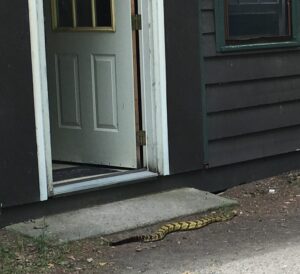
Mr. Rattlesnake at Camp Mohican in Blairstown, NJ. Good thing he opted to stay out of the Dining Hall!
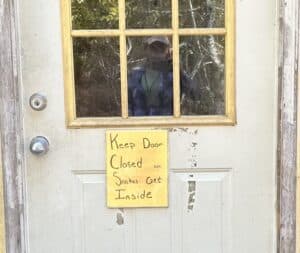
Since then, they posted this sign. A good tip!
Speaking of rattlesnakes… One time, I suddenly came upon a coiled rattlesnake in the woods while walking Miss Ellie on a retractable lead. Ellie passed by the snake. I was about 6 feet behind and almost stepped on it, hidden in the thick shadows of the forest floor. Like a hurdle jumper, I launched over the snake. Note to self, don’t wear sunglasses in heavy shade in the woods.
Benefits of Snakes
There are benefits of snakes in the garden. But agreed the benefits may not outweigh the risk of copperheads or rattlesnakes, thank you very much. Nothing against you, lovely snakes. Baby copperheads feed on insects, including garden pests, whereas adults feed on mice and rats (carriers of ticks, which is a good thing), but also on birds, frogs, and such. They say they aren’t fond of strong smells, and so planting herbs, onions, garlic, lemongrass, and marigolds may help keep them out of the garden.
I am relieved to know that while they are venomous, they are not as deadly as rumor has it, although to small animals, they can be. Nobody’s ever endured a snake bite while they were leaving it alone. But of course, there is the element of surprise. If bitten, you should seek medical treatment.
A Poem by Mary Oliver about Copperheads
There’s a poem titled May by Mary Oliver, in which she comes upon a copperhead. Curious, she knelt to gaze, noticing he wasn’t shy, unlike other snakes.
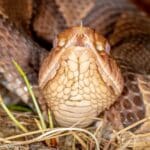
Copperhead Photo by Blaine Rothauser
She moved a bit, and it “clamped its eyes on mine; then it jerked towards me.”
She jumped back and watched the snake slither away; her heart pounding. I adore how the poem ends, when she lingers listening to the woodland sounds and staring at the stars.
“After excitement, we are so restful. When the thumb of fear lifts, we are so alive.”
Garden Dilemmas? AskMaryStone@gmail.com and your favorite Podcast App.
There’s more in the Garden Dilemmas Podcast, including other wildlife encounters that instill fear, followed by excitement and wonder:
Related Posts and Podcasts:
Ep 211. Truth and Tale of Two Country Gardens
Japanese Stilt Grass & Thistle Remedies – Blog Post


